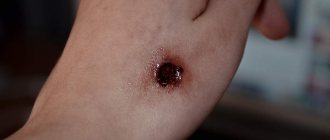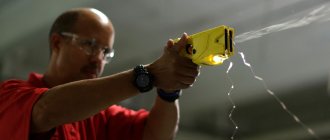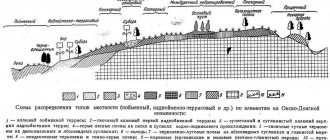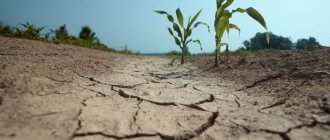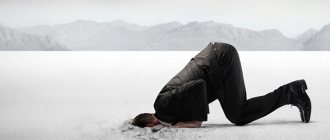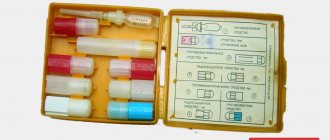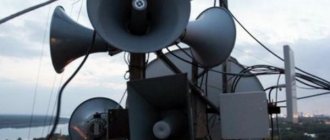Personal protective equipment for skin
Filter skin protection products
| Set of protective filter clothing ZFO-58, FZO-MP | Exit to section | Combined arms integrated protective suit OKZK (OKZK-M) |
The simplest (available) skin protection products
Available means of skin protection include household and industrial clothing and footwear, adapted to protect against radioactive substances and bacterial agents and, in some cases, against toxic substances.
Capes and raincoats made of rubberized fabric and synthetic film materials protect against contact of radioactive substances and bacterial agents with the skin.
They protect against droplet-liquid agents in summer (hot) time for no more than 10 minutes.
Industrial clothing - jackets and trousers, overalls, canvas raincoats with hoods, robes made from fire-retardant or rubberized fabric, coarse cloth, tarpaulin, synthetic fabric - can not only protect people from contact with radioactive substances and bacterial agents, but also not allow droplet-liquid toxic substances to pass through for a certain period of time.
To protect the skin, the following can be used: sportswear, jackets and overalls made of synthetic and rubberized fabric, winter clothes made of coarse cloth, drape, canvas fabric, cotton jackets and trousers. After appropriate preparation, other types of outerwear can also provide skin protection: suits, jackets, trousers made of various fabrics.
To protect your feet, you can use rubber and leather shoes, as well as shoes made of various leatherettes for household and industrial use. Rubber products do not allow droplet-liquid agents to pass through for 3-6 hours.
Hands can be protected with rubber or leather gloves. Canvas, wool, knitted and cotton gloves and mittens can only protect the skin of your hands from radioactive substances and bacterial agents.
It must be remembered that in order to protect the skin from radioactive, toxic substances and bacterial agents using the outerwear, shoes, gloves, and hats at your disposal, it is necessary to ensure maximum sealing of the body from contaminated air. Clothing adapted to protect the skin must be used together with personal respiratory protection equipment.
Ordinary household and industrial clothing does not create a complete seal. The places where it is leaking are usually: the chest slit, the collar, the lower edge of the jacket (jacket), trousers and the connection of the sleeves with the gloves. To ensure the tightness of ordinary clothing, it is necessary to make a chest flap from any fabric. It is a rectangle 80 cm long and 25 cm wide with the corners of the upper end of the bib cut off. To protect the neck, open parts of the head and create a tight seal in the collar area, a simplified hood is used. It is made from thick cotton or wool fabric.
Instead of a hood, you can use ordinary scarves, pieces of fabric, scarves, hoods, etc.
The side slits of the trousers (pockets) are sealed with sewn-in wedges located under the slits.
The tightness of clothing at the junction of the jacket with trousers, sleeves with gloves, and the bottom edge of trousers with shoes is achieved by appropriate tucking. To protect against radioactive dust and bacterial agents, you can use homemade capes, stockings and gloves. To make them, thick fabrics and oilcloth are used.
Ordinary clothing, in addition to protection against radioactive substances, can also be used to protect against vapors and aerosols of toxic substances. To do this, it is impregnated either with a solution of synthetic detergents (OP-7, OP-10, “Novost”, “Astra”, “Era”, “Don”, etc.), or with a soap-oil emulsion based on minerals (crankcase, transformer , machine, etc.) or vegetable (sunflower, corn, linseed, cottonseed, etc.) oils.
To prepare a solution of the first composition, take 500 g of synthetic detergent and dissolve it in 2.5 liters of water heated to 40-50 0C; the mixture is stirred for 2-3 minutes until a homogeneous light yellow solution is obtained. To prepare a solution of the second composition, 250-300 g of crushed laundry soap are dissolved in 2 liters of water heated to 60-70 0C; when the soap is completely dissolved, add 0.5 liters of mineral (vegetable) oil. The resulting mixture is stirred for 5 minutes, slightly heating, until a homogeneous emulsion is obtained. After preparing the solution, the clothes intended for impregnation are placed in a container of the required volume and filled with hot impregnating solution. After impregnation with the solution, the clothes are turned inside out and soaked again. The clothes are then lightly wrung out and air dried.
Clothes prepared in this way can be worn directly over underwear.
Winter coats, padded jackets (jackets, trousers and other similar types of clothing) are not impregnated, but are used as protective clothing, complete with underwear soaked in one of the solutions.
Available skin protection means are worn immediately before the threat of injury from radioactive, toxic substances or bacterial agents.
Adapted clothing is worn in the following order: trousers and jacket, shoes. When you are about to cross an area contaminated with toxic substances, stockings (socks) treated with an impregnating solution are put on ordinary stockings (socks).
The clothing worn must be fastened with all buttons, hooks or buttons, the collar raised, and the neck tightly tied with a scarf or handkerchief; the sleeves are tied around the wrists with ribbons; the trousers are placed over the boots (boots) and tied at the bottom with braid. Clothes need to be belted.
The last thing to put on is a gas mask (in case of radioactive or bacteriological contamination, you can use a respirator, a PTM-1 mask or a cotton-gauze bandage), raise the collar of a jacket, raincoat, coat and tie it with a scarf, put on a headdress, hood, gloves (mittens).
When crossing areas contaminated with toxic substances, it is advisable to wear a raincoat or cape made of rubberized or synthetic fabric over the clothes you are wearing.
After leaving the contaminated area, you must quickly remove your clothes, taking precautions, and disinfect them as soon as possible, but no later than an hour later. Disinfected and cleanly washed clothing can be reused as protection by first soaking it in an impregnating solution.
Source
Personal protective equipment against falls from height
To perform work at height, installers, rescue workers and other services must use safety systems that provide reliable protection against falling from a great height and death. Workers or climbing athletes wear such products on themselves, due to which the load during a fall is distributed to the strongest parts of the body, which prevents falls from a height and the risk of injury.
For work, sports or personal purposes, you need to use safety systems that meet certain requirements of state standards. According to the regulatory framework, safety harnesses consist of the following parts:
- Chest harness. The upper harness includes a wide power belt covering the chest and torso, and straps that are secured over the shoulders. Such products are often used when working at low heights, with minimal risk of falling and prolonged free hanging, because they place high pressure on the chest.
- "Gazebos". These are elements of the lower safety system, which include a life belt and leg loops. They are usually equipped with elements for adjusting the length of the straps, which allows the product to be tightly fixed to the body.
Often, mountaineering workers and rescue workers use combined safety systems, which include a rescue belt, leg and shoulder straps that are interconnected. Such products provide the greatest safety and minimal risk of injury, even if a person suddenly falls or turns upside down.
The main elements of fall protection systems include:
- buckles (with forward and reverse movement of belts):
- rings: these are the key parts that connect all elements into one system;
- loops (“balconies”, “shelves”): they provide convenient hanging of equipment (guys, bookmarks, friends, bolts); loops are prohibited from being used as “cargo” elements, since they can only withstand up to 10 kg;
- safety ropes, belts;
- harnesses, slings (with and without shock absorption);
- anchor, blocking elements, etc.
Handy personal protective equipment for skin
as available means of protecting human skin: jackets, trousers, overalls, robes with hoods, sewn in most cases from tarpaulin, fire-retardant or rubberized fabric, coarse cloth. They are capable of not only protecting from radioactive substances that come into contact with the skin, but also from drops, vapors and aerosols of many toxic substances. Tarpaulin products, for example, protect against droplet-liquid agents and airborne chemicals for up to 1 hour in winter, and up to 30 minutes in summer.
Winter items can also provide protection for up to 2 hours: coats made of rough cloth or drape, quilted jackets, sheepskin coats, leather coats. It all depends on specific weather and other conditions, the concentration and state of aggregation of potent toxic or toxic substances.
After appropriate preparation, other types of outerwear can also provide protection: tracksuits, jackets, especially leather ones, denim, raincoats made of waterproof fabric.
To protect your feet, it is best to use industrial or household rubber boots, rubber boots, and galoshes. You can also use shoes made of leather and leatherette, but preferably with rubber galoshes. Rubber products are capable of preventing the passage of droplet-liquid agents and SDYAVs for up to 3 - 6 hours.
You should wear rubber or leather gloves on your hands, or canvas mittens.
Personal medical protective equipment
Medical protection is a set of activities carried out (organized) by the disaster medicine service and the civil defense medical service (MS Civil Defense) to prevent or minimize the impact on the population and rescuers of the damaging factors of emergency situations. Medical protection is an integral part of health care provision.
Medical protection measures include:
•
assistance in providing individual means of injury prevention (antidotes, radioprotectors, special treatment agents, etc.), medications for first aid, as well as participation in training in the rules and techniques for using them
;
Handy skin protection products
Handy skin protection products
- These are items of clothing and shoes that every person can have.
To protect the population, industrial protective clothing can be used as the simplest protective clothing - jackets and trousers, overalls, robes with hoods, sewn in most cases from coarse cloth, tarpaulin, fire-retardant or rubberized fabric. It not only protects against contact of radioactive substances and bacterial agents with human skin, but also does not allow droplet-liquid agents to pass through for some time. Clothing made of tarpaulin protects against toxic substances (in winter - up to 1 hour, in summer - up to 30 minutes). Of the items of household clothing, the most suitable for protecting the skin are raincoats and capes made of fabric rubberized or covered with vinyl chloride film, winter items - coats made of coarse fabric or drape, quilted jackets, and the like. A coat made of cloth or drape together with other clothing protects against droplet-liquid agents: in winter - up to 1 hour; in summer - up to 20 minutes; quilted jacket - up to 2 hours. To protect your feet, you need rubber boots, overshoes, and galoshes: they do not allow droplets to pass through for up to 3-6 hours. You need to wear rubber or leather gloves on your hands.
Clothes should be fastened with all buttons, hooks or buttons, the collar should be raised, and a scarf or handkerchief should be tied on top of it around the neck; tie the sleeves around the wrists with braids; Place the trousers over the boots (boots) and tie them at the bottom. To enhance the tightness of clothing, special valves are used that close the slits of jackets or jackets on the chest, and wedges are sewn into the slits on the sleeves and pants. You can sew a hood from thick fabric or synthetic film to protect your neck and head.
At home, if there is a threat of injury from radioactive, toxic substances or bacterial agents, everyone should be able to adapt available means to protect the skin - industrial, sports and everyday (household) clothing and shoes. Here's how to do it.
To increase the protective properties of clothing against chemical agent vapors, it is necessary to impregnate it with a special solution. To impregnate one set of clothes, it is enough to dissolve 250-300 g of crushed laundry soap in 2 liters of hot water and add 0.5 liters of vegetable or mineral oil, then heat the solution. After impregnation, the clothes are lightly wrung out and dried in the open air.
If the protective properties of the suit are not enough, raincoats and capes made of waterproof material are put on top of it. Such clothing protects against contact with the skin of chemical agents and chemical agents; it protects from droplet-liquid agents in the summer for about 10 minutes. To protect your feet and hands - mittens, gloves, rubber boots, galoshes, felt boots, etc.
conclusions
1) Personal protective equipment (PPE) protects against contact of radioactive, toxic substances and biological agents with the skin.
2) Personal protective equipment for the skin is divided into improvised and special personal protective equipment for the skin (SPS).
3) Regular medical personal protective equipment also includes medical equipment: an individual first aid kit (AI-2), an individual anti-chemical package (IPP-8).
4) Citizens of the DPR are required to study the rules for using personal protective equipment and be able to adapt their clothing to protect the respiratory system, eyesight and facial skin from radioactive substances and hazardous chemicals.
Read the text carefully: “...the set of this protective clothing consists of a protective raincoat, protective stockings, and protective gloves.” What kind of protective clothing are we talking about:
a) general-arms protective kit;
b) a set of protective filter clothing;
c) light protective suit L-1.
1. Among the items of household clothing most suitable for protecting the skin:
a) raincoats and capes made of rubberized fabric or covered with vinyl chloride film;
b) fur winter clothes;
c) short jackets, jackets made of thick material.
1. Personal skin protection products are used to protect:
a) human skin.
b) organs of vision;
c) respiratory organs;
5. The main components of the simplest personal skin protection products:
a) combined arms protective suit (OZK);
b) household clothes;
c) light protective kit (L-1).
| Question | 1 | 2 | 3 | 4 | 5 |
| Correct answer | V | A | A | A | b |
Give answers to the questions:
1.Name the composition and purpose of skin protection products.
2.What is the most reliable means of skin protection?
Source
How to use
The effectiveness of using protective equipment at an enterprise depends on the correctness of their choice. The selection of necessary elements should be carried out taking into account the type of activity and the impact of hazardous environmental factors on workers. The employee must understand what personal protective equipment is and use these items correctly.
Protective clothing
Elements for protecting human skin from harmful influences are suits and overalls. If necessary, these collective protective equipment are equipped with gloves, masks, and special shoes. Overalls can be insulating or filtering. Kits of the first type are made of airtight materials. They provide reliable protection in conditions of radiation and bacteriological contamination. These include a general military protective kit, which consists of a rubberized raincoat, boots, and gloves.
Filter clothing is made from special materials impregnated with chemicals. The fabric does not allow harmful vapors to pass through, while remaining breathable. Individual anti-chemical protective clothing sets are used for work in areas of disasters, accidents, and hazardous industries. Robes and jackets made from ordinary fabrics are simple means of protecting human skin from biological agents. They are designed for work in production and protect against dirt, water, and dust.
To protect feet from water and harmful solutions, special work shoes are provided. These can be rubber boots with additional protective elements (reinforced toe). Protect your hands with cotton or rubber gloves. All employees are required to use the facilities provided to them. At the beginning of the shift, the foreman must check the availability of protective kits and their correct operation. Items unsuitable for work are replaced with new ones as they wear out.
Mounting belt
For installation work, special personal protective equipment has been developed to prevent falls from height. This device can be made in the form of a safety belt or slings with carabiners. They come in strap and tape types. These elements are used by rescue services, installers, and industrial climbers. The slings can be equipped with shock absorbers that provide a soft touch to the surface without jerking. The belt is worn over the work overalls and secured with clips.
Respiratory and skin protection
The most reliable element that protects a person’s face and respiratory tract from toxic substances is a gas mask. It works on the principle of filtration or isolation from external influences. Filtering gas masks are equipped with an air purification system. This device is the main element among personal respiratory protection equipment. Gas masks are divided into civil and industrial. They have different purposes.
Modern civilian gas masks, which include filter masks, are used for the defense of the population. If you detect signs of bacteriological infection, you should put a helmet-mask on your head. When put on correctly, the gas mask should fit snugly to the face, and the glasses should be exactly in front of the eyes. These funds are issued to the population in special bags. There are modifications for children that protect the child from harmful environmental emissions. Filter systems are used for this.
Insulating gas masks are designed for work in areas affected by radioactive substances (nuclear accidents, catastrophes). They are used in cases where filter elements cannot provide the required level of protection. Industrial gas masks block the entry of contaminated air into the human body. The protection element is equipped with a breathing bag, a regenerative cartridge and a bag. Gas masks are stored in accordance with the instructions of sanitary inspection authorities.
- Charlotte cream - recipes step by step with photos. How to prepare Charlotte cream for cake according to GOST and chocolate
- How to spot internal bleeding
- Pasta sauce - recipes with photos. How to prepare pasta sauce with or without minced meat
Respirators are used in hazardous industries to protect the respiratory tract of workers from harmful impurities. This product is a half mask with filter fabric. When using a respirator, you must ensure that it fits tightly to your head to prevent contaminated air from entering your lungs. Using available materials, workers can make their own anti-dust gauze bandage.
Organs of vision
Special glasses are used to protect eyes in production. Glass can be shockproof, metallized, equipped with light filters. The first type of glasses is used when working with hard materials: metal, wood, stone. They provide eye protection from chips, sparks, and industrial dust. Glasses with filters protect vision from ultraviolet and infrared waves. Personal eye protection can be presented in the form of:
- head shields;
- masks;
- helmets
Head PPE
In factories and construction enterprises, the workwear set includes helmets and special headgear. The purpose of personal protective equipment for the head is to protect a person from mechanical injury. Additionally, they protect the hair and neck from dirt and dust. Helmets are used during installation work in industrial production. Additionally, they can be equipped with balaclavas, goggles, and elements to protect the neck.
Personal protective equipment for skin
In conditions of nuclear, chemical, bacteriological contamination when the human body is exposed to toxic, radiation substances, biological agents, as well as the light flux of a nuclear explosion, the need arises to protect the entire human body. Skin PPE is used for these purposes.
Skin PPE is usually called products that complement or replace a person’s normal clothing and footwear and are made from special materials.
According to the principle of protective action, like respiratory protection products, skin protection products can be insulating or filtering.
Insulating skin PPE is made from rubberized fabric and is used when people spend a long time in a contaminated area, when performing decontamination and disinfection work in affected areas and infection zones.
Isolating protective equipment includes: general-arms protective set OZK, light protective suit L-1, protective sets KIKH-4, KIKH-5. As a rule, most PPE is used to protect both civilians and military personnel.
Combined arms protective kit OZK
It is used in conducting radiation chemical and bacteriological reconnaissance, as well as for protecting personnel in conditions of chemical and bacteriological attack.
What is personal protective equipment (PPE)?
Personal protective equipment (PPE) is a set of clothing, accessories and equipment that allows you to minimize or eliminate the harmful effects of environmental factors on a person’s skin, as well as on their respiratory, vision and hearing organs. In accordance with this formulation, all PPE can be divided into:
- Personal respiratory protection;
- personal eye protection equipment;
- personal hearing protection equipment;
- personal protective equipment for skin.
Unfavorable environmental factors include: dust, pollution, toxic chemicals, molten metals, boiling liquids, solid particles, and atmospheric phenomena.
The choice of PPE is determined by specific working conditions in production or the degree of chemical damage to the environment.
Our country has adopted a classification of personal protective equipment, which provides for several categories of special equipment used in various industries:
- protective clothing (overalls, robes, jackets, trousers, sheepskin coats, vests, capes, aprons, etc.);
- special footwear and special equipment for protecting feet (boots, shoes, shoe covers, knee pads, over the knee boots, etc.);
- special equipment to protect the head and face (helmets, caps, mosquito nets, hats, shields, etc.);
- special equipment for protecting hands (rubber and fabric gloves, finger caps, sleeves, wristbands, etc.);
- insulating suits (suits for diving, pneumatic suits, spacesuits, etc.);
- special equipment for respiratory protection (respirators, masks, gas masks, etc.);
- special equipment for protecting the visual organs (protective glasses);
- special equipment for hearing protection (ear plugs, headphones, helmets and earplugs).
Among other things, the concept of PPE also includes such specific types of equipment as means to prevent falls from heights (belts, cables, etc.) and dermatological protective agents (creams, reparators, cleaners, filters, etc.) . Based on the above list, we can conclude that personal protective equipment combines various products and equipment that a worker uses to ensure his own safety when exposed to adverse factors in the working environment. One of the main attributes of PPE is workwear, which is used along with other personal protective equipment in many areas of production. In particular, workwear is required to be worn by representatives of such professions as: builders, electricians, installers, mechanics, as well as workers in the metallurgical, pharmaceutical, chemical, food, and light industries.
Workwear allows you to protect people from various types of mechanical, chemical, and thermal damage, ensuring an appropriate level of occupational safety. In addition, workwear plays an important role in the advertising campaign of an enterprise and the promotion of its products. Psychologists talk about the effect of workwear, when people dressed in the same uniform feel like part of a team united by a common goal. This approach always has a positive effect on the results of work in the team. That is why experts recommend choosing clothes and shoes for work based on considerations of comfort, practicality, safety, and at the same time be sure to put the company logo on them.
Workwear is made from materials that provide the maximum degree of protection for the worker from specific production factors or the environment. Overalls include:
- work suit, raincoat, overalls;
- work shoes;
- protective headgear;
- respirator for respiratory protection;
- work gloves gloves.
At the same time, each type of workwear must meet the requirements of the Labor Code at the enterprise and guarantee the appropriate degree of personnel protection. In the manufacture of workwear, materials of increased strength are used, as well as materials with water-repellent, fire-resistant impregnation, hygienic and antistatic materials, etc.
The following requirements apply to personal protective equipment:
- Compliance with climatic conditions and season, which includes the use of summer, winter and demi-season equipment.
- Strength, wear resistance and durability of materials. Any type of workwear must guarantee a long service life (at least 2-3 years) while maintaining a decent and aesthetic appearance. In complex production processes, the use of clothing with heat-resistant or reinforced fibers is justified.
- High quality tailoring and manufacturing of PPE guarantees employee safety.
- Compliance with the specifics of the work performed. Workwear must provide ease of movement and manipulation, therefore, for each professional field of application, a certain style and cut of clothing with the required number of pockets, fasteners, etc. has been developed.
- Practicality, reliability. The worker's protective suit must have a low degree of contamination, be easy to wash and not change its characteristics after exposure to various reagents and powders.
- The hygroscopicity and hygiene of the products will ensure proper employee comfort while performing work.
- Aesthetic appearance of workwear.
Thus, personal protective equipment can guarantee not only the safety of the worker, but also provide maximum comfort and convenience throughout the working day.
Respirator for painting: safety of your respiratory tract
Choosing the right work gloves
Personal protective equipment for skin: types
Radioactive, toxic substances and bacterial agents can penetrate the human body not only through the respiratory system, but also through the skin.
Therefore, in case of danger of radiation, chemical, bacteriological contamination, in case of accidents and natural disasters with the release of hazardous substances, it is necessary to protect not only the respiratory organs, but also the entire human body and skin. For this purpose, personal skin protection products are used.
Skin protection means include special clothing made from special materials (rubberized fabrics, coarse cloth, tarpaulin, polyethylene and other moisture- and dust-proof materials) and protecting the skin from toxic, radioactive substances, bacterial agents and hazardous chemicals.
Skin protection products are classified according to their purpose, principle of use and principle of action.
According to their intended purpose, skin protection products (SPA) are divided into standard and improvised:
● general-arms (OZK, impregnated, i.e. impregnated with a special composition that retains or neutralizes vapors of chemical agents or hazardous chemicals, uniforms and a set of protective equipment), which are provided to military units;
● special (light protective suit L-1, emergency insulating suit), intended for emergency rescue teams;
● assistants – used by the population.
The standard ones reliably protect the skin from gases, vapors, aerosols and droplet-liquid agents, chemical agents, radioactive substances and BS.
Completely protect against the effects of alpha particles, significantly reduce the impact of beta radiation.
Improvised SZK, which includes ordinary clothing and shoes, are used by the population in the absence of service equipment.
According to the principle of use , protective equipment is divided into means of constant wear (combined arms set of protective equipment and impregnated uniforms), means of periodic wear, including single and multiple use (light protective suit, combined arms protective set, chemical set, etc.)
Insulating SZK are designed to protect the skin from radioactive substances, BS and from harmful substances in the liquid phase (aerosols, droplets).
Insulating SZK are made of airtight rubberized fabrics or polymer materials, usually special elastic and frost-resistant fabric.
They can be sealed or not sealed. Sealed protective equipment covers the body and protects from vapors and drops of chemical agents, while non-sealed protective equipment only protects from drops of chemical agents.
Individual protection means
Information for the public about personal protective equipment
In the complex of protective measures, it is important to provide the population with personal protective equipment and practical training in the correct use of these equipment in conditions of the enemy’s use of weapons of mass destruction.
Personal protective equipment for the population is intended to protect against the ingress of radioactive, toxic substances and bacterial agents into the body, skin and clothing.
Personal protective equipment includes:
- respiratory protection equipment (respirators, gas masks, lifeguards made from improvised means, anti-dust fabric masks and gauze bandages),
- skin protection means (protective suits, rubber boots, etc.),
- medical protective equipment (individual first aid kit AI-2, individual anti-chemical package, individual dressing package).
Respiratory protection
Respirators are a lightweight means of protecting the respiratory system from harmful gases, vapors, aerosols and dust.
Respirators are divided into two types:
- The first is respirators in which the half mask and filter element simultaneously serve as the front part;
- The second is a respirator that purifies inhaled air in filter cartridges attached to a half mask.
According to their intended purpose, they are divided into anti-dust, anti-gas and gas-dust protective. Anti-dust protects the respiratory system from various types of aerosols, anti-gas from harmful vapors and gases, and gas-dust from gases, vapors and aerosols with their simultaneous presence in the air.
The gas mask is used as an independent personal protective equipment, or in combination with other means (for example, with a combined arms protective kit).
Gas masks differ in types of protection:
filtering - from specific types of emergency chemical toxic substances, filtering the ambient air, it is usually possible to replace the filter element.
isolating - generation of a respiratory mixture, that is, the respiratory organs breathe not with the surrounding air, but with the air generated by the regenerative cartridge and the oxygen enrichment system.
hose - supply of air mixture from some distance (10-40 meters), usually used when working in containers.
The gas mask consists of a front part (mask, helmet-mask), a filter-absorbing box, which are connected to each other directly or using a connecting tube.
The gas mask kit includes a bag and anti-fog films, and, depending on the type of gas mask, there may also be intercom membranes and a knitted cover. The filter-absorbing (gas-mist) box is designed to purify the air inhaled by a person from vapors and aerosols of toxic, highly toxic and radioactive substances, as well as bacterial agents.
To protect the population, the most widely used filtering civilian gas masks are GP-7 (GP-7V), which look like this:
